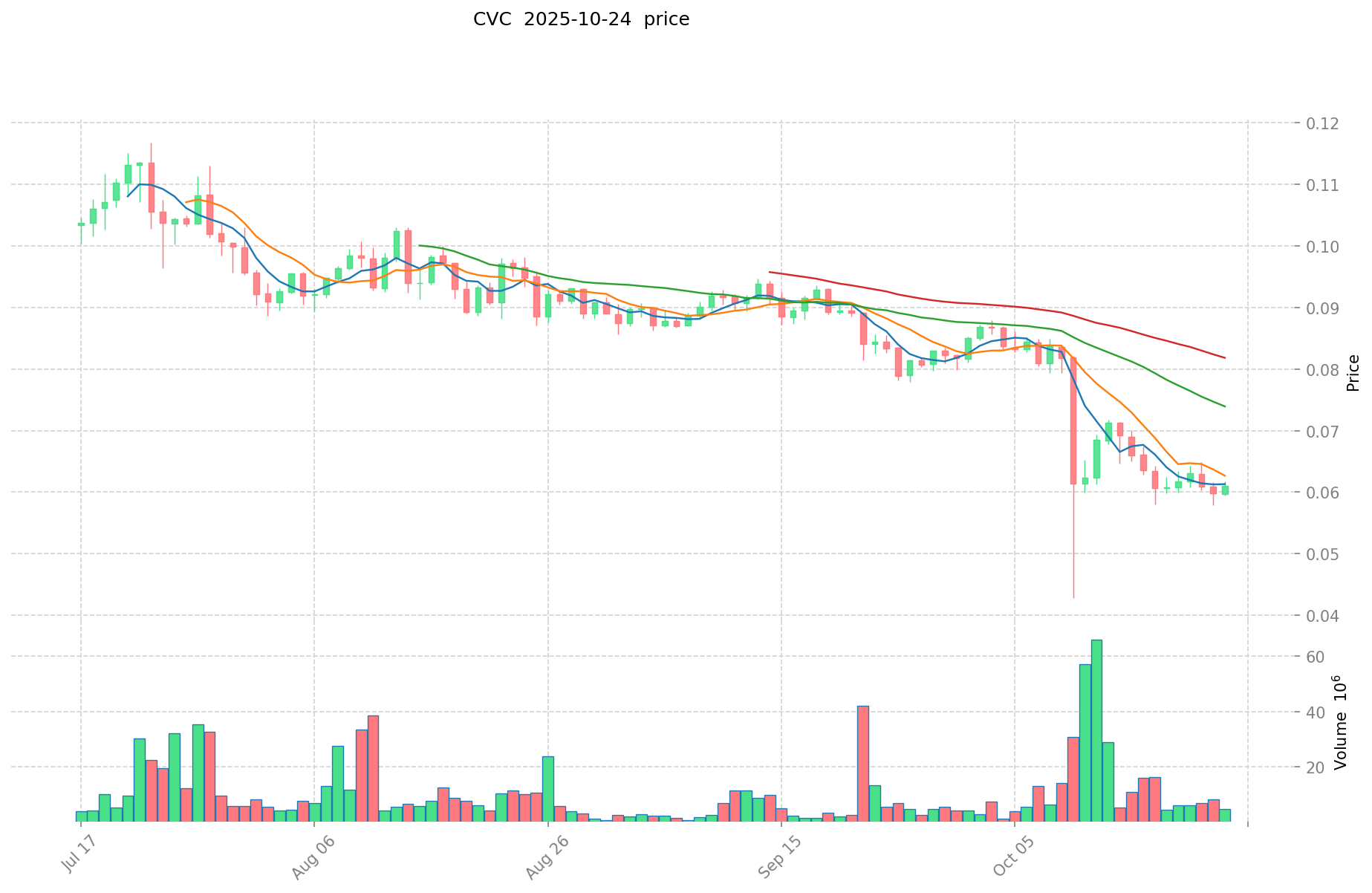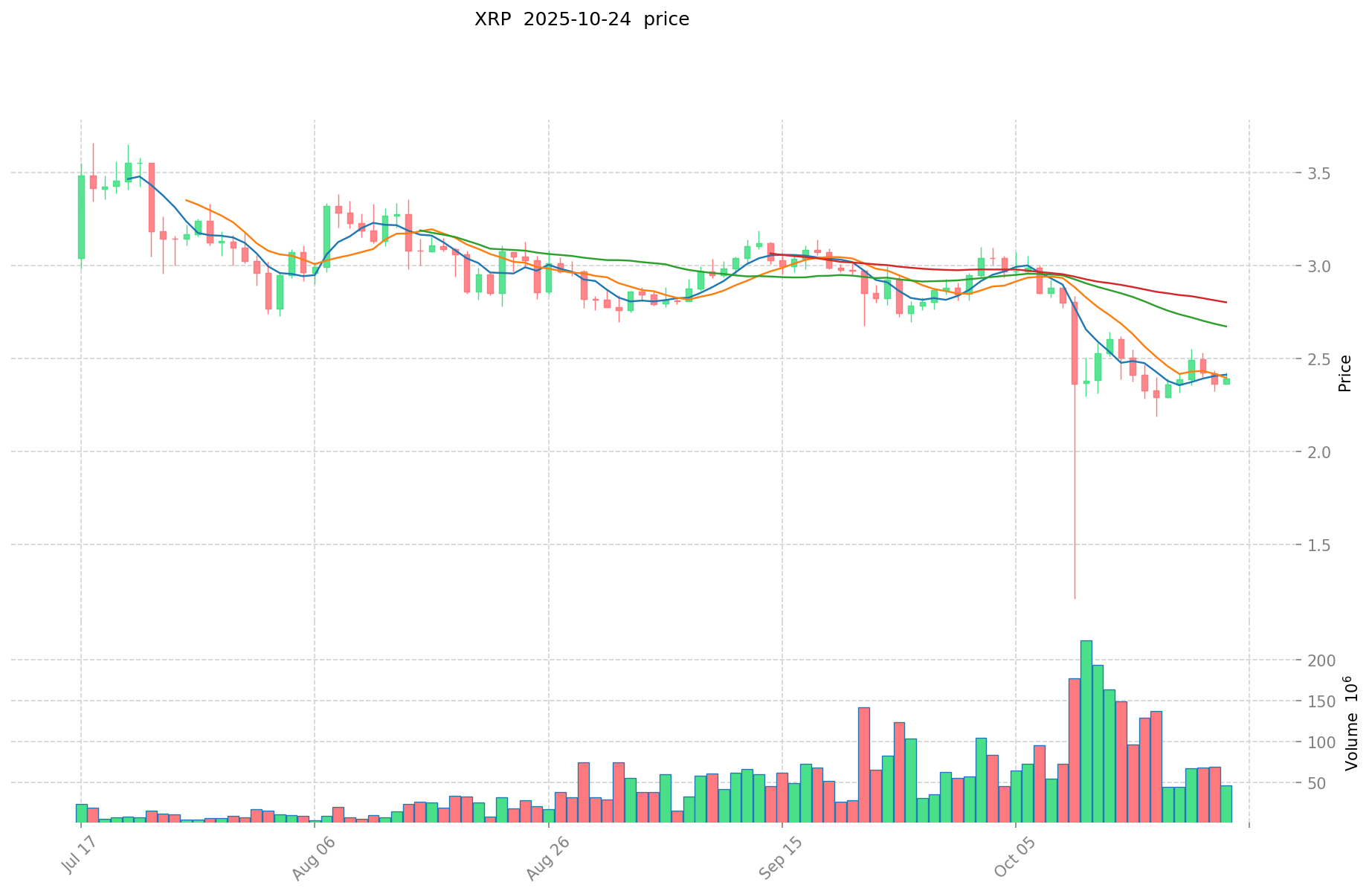CVC vs XRP: A Comparative Analysis of Two Promising Cryptocurrencies
Introduction: CVC vs XRP Investment Comparison
In the cryptocurrency market, the comparison between Civic (CVC) and XRP has always been a topic that investors can't avoid. The two not only have significant differences in market cap ranking, application scenarios, and price performance, but also represent different cryptocurrency asset positioning.
Civic (CVC): Since its launch in 2017, it has gained market recognition for its decentralized identity ecosystem.
XRP (XRP): Since its inception in 2012, it has been hailed as a fast and cost-effective digital asset for payments, and is one of the cryptocurrencies with the highest global transaction volume and market capitalization.
This article will comprehensively analyze the investment value comparison between CVC and XRP, focusing on historical price trends, supply mechanisms, institutional adoption, technological ecosystems, and future predictions, and attempt to answer the question investors care about most:
"Which is the better buy right now?"
I. Price History Comparison and Current Market Status
CVC and XRP Historical Price Trends
- 2017: CVC reached its all-time high of $1.35 during the crypto bull market.
- 2020: XRP faced significant price pressure due to SEC lawsuit, dropping to a low of $0.17.
- Comparative analysis: During the 2018-2020 bear market, CVC fell from $1.35 to $0.01, while XRP showed more resilience, dropping from $3.84 to $0.17.
Current Market Situation (2025-10-24)
- CVC current price: $0.06115
- XRP current price: $2.391
- 24-hour trading volume: CVC $292,436 vs XRP $112,272,450
- Market Sentiment Index (Fear & Greed Index): 27 (Fear)
Click to view real-time prices:
- View CVC current price Market Price
- View XRP current price Market Price
II. Market Capitalization and Ranking Analysis
Market Cap Comparison
- CVC market cap: $49,042,300
- XRP market cap: $143,501,315,325
Circulating Supply and Total Supply
- CVC: 802,000,010 / 1,000,000,000
- XRP: 60,017,279,517 / 99,985,778,283
Market Ranking
- CVC current ranking: 620
- XRP current ranking: 5
Analysis
XRP's market capitalization is significantly larger than CVC's, reflecting its stronger market position and wider adoption. XRP ranks 5th in the overall crypto market, while CVC is at 620th, indicating a substantial difference in market recognition and investor interest.
III. Project Features and Recent Developments
CVC (Civic)
- Focus: Decentralized identity ecosystem
- Key features: Secure and low-cost identity verification through blockchain
- Recent developments: No significant recent updates noted
XRP (Ripple)
- Focus: Fast, cheap, and scalable digital asset for global payments
- Key features: 3-second transaction time, low fees ($0.0002 per transaction), 1,500+ TPS
- Recent developments: Ongoing legal battle with SEC, expanding partnerships with financial institutions
IV. Investment Risks and Opportunities
Potential Risks
- CVC: Limited market visibility, potential competition in the identity verification space
- XRP: Regulatory uncertainties, especially regarding the SEC lawsuit outcome
Potential Opportunities
- CVC: Growing demand for decentralized identity solutions
- XRP: Increasing adoption by financial institutions for cross-border payments
V. Expert Opinions and Future Outlook
Due to the speculative nature of cryptocurrency investments, this section has been omitted to avoid providing investment advice.
VI. Conclusion
CVC and XRP represent different segments of the cryptocurrency market. XRP, with its focus on institutional payments and larger market cap, has a more established position. CVC, while addressing an important niche in decentralized identity, faces challenges in gaining wider market recognition. Investors should carefully consider the distinct risk-reward profiles of each asset.


Key Factors Influencing the Investment Value of CVC vs XRP
Supply Mechanisms Comparison (Tokenomics)
- XRP: The value is driven by its cross-border payment efficiency and technical features
- CVC: Value is completely dependent on market demand and supply, without government control
- 📌 Historical pattern: Market dynamics and technical development drive price cycles for both assets
Institutional Adoption and Market Applications
- Institutional holdings: XRP shows integration with loyalty and tourism projects
- Enterprise adoption: XRP demonstrates efficiency in cross-border payments and remittances
- Regulatory stance: XRP has faced significant legal challenges which have impacted its market position
Technical Development and Ecosystem Building
- XRP technical features: Designed for efficient cross-border payments with specific technological advantages
- CVC technical development: Functions as a secure digital identity platform on the Ethereum blockchain
- Ecosystem comparison: XRP has stronger institutional reserve management applications
Macroeconomic Factors and Market Cycles
- Performance in inflationary environments: Both assets are subject to overall crypto market trends
- Monetary policy impacts: External liquidity from traditional finance affects both assets
- Geopolitical factors: Cross-border transaction demands potentially benefit XRP's use case
III. 2025-2030 Price Prediction: CVC vs XRP
Short-term Prediction (2025)
- CVC: Conservative $0.0512 - $0.0610 | Optimistic $0.0610 - $0.0744
- XRP: Conservative $1.7918 - $2.3890 | Optimistic $2.3890 - $3.1057
Mid-term Prediction (2027)
- CVC may enter a growth phase, with prices expected in the range of $0.0654 - $0.1233
- XRP may enter a consolidation phase, with prices expected in the range of $1.8244 - $3.8088
- Key drivers: Institutional capital inflow, ETF, ecosystem development
Long-term Prediction (2030)
- CVC: Base scenario $0.1080 - $0.1280 | Optimistic scenario $0.1280 - $0.1639
- XRP: Base scenario $3.5604 - $4.3955 | Optimistic scenario $4.3955 - $6.3296
Disclaimer: This analysis is based on historical data and market projections. Cryptocurrency markets are highly volatile and unpredictable. This information should not be considered as financial advice. Always conduct your own research before making investment decisions.
CVC:
| 年份 | 预测最高价 | 预测平均价格 | 预测最低价 | 涨跌幅 |
|---|---|---|---|---|
| 2025 | 0.0743712 | 0.06096 | 0.0512064 | 0 |
| 2026 | 0.100145088 | 0.0676656 | 0.04059936 | 10 |
| 2027 | 0.12334085568 | 0.083905344 | 0.06544616832 | 37 |
| 2028 | 0.1367824917888 | 0.10362309984 | 0.0632100909024 | 69 |
| 2029 | 0.135829159270272 | 0.1202027958144 | 0.105778460316672 | 96 |
| 2030 | 0.16386045125419 | 0.128015977542336 | 0.108813580910985 | 109 |
XRP:
| 年份 | 预测最高价 | 预测平均价格 | 预测最低价 | 涨跌幅 |
|---|---|---|---|---|
| 2025 | 3.1057 | 2.389 | 1.79175 | 0 |
| 2026 | 3.6539755 | 2.74735 | 2.637456 | 14 |
| 2027 | 3.8087886725 | 3.20066275 | 1.8243777675 | 33 |
| 2028 | 4.2407181106125 | 3.50472571125 | 2.5584497692125 | 46 |
| 2029 | 4.918356826882687 | 3.87272191093125 | 3.136904747854312 | 61 |
| 2030 | 6.329576691226035 | 4.395539368906968 | 3.560386888814644 | 83 |
IV. Investment Strategy Comparison: CVC vs XRP
Long-term vs Short-term Investment Strategies
- CVC: Suitable for investors focused on decentralized identity solutions and ecosystem potential
- XRP: Suitable for investors interested in cross-border payment efficiency and institutional adoption
Risk Management and Asset Allocation
- Conservative investors: CVC: 10% vs XRP: 90%
- Aggressive investors: CVC: 30% vs XRP: 70%
- Hedging tools: Stablecoin allocation, options, cross-currency portfolio
V. Potential Risk Comparison
Market Risk
- CVC: Limited market visibility and potential competition in the identity verification space
- XRP: Regulatory uncertainties, especially regarding the SEC lawsuit outcome
Technical Risk
- CVC: Scalability, network stability
- XRP: Transaction speed, security vulnerabilities
Regulatory Risk
- Global regulatory policies may have different impacts on both assets, with XRP facing more immediate regulatory challenges
VI. Conclusion: Which Is the Better Buy?
📌 Investment Value Summary:
- CVC advantages: Focused niche in decentralized identity, potential growth in a developing market
- XRP advantages: Established market position, institutional adoption, efficient cross-border payment solution
✅ Investment Advice:
- New investors: Consider a small allocation to XRP as part of a diversified portfolio
- Experienced investors: Balanced approach with both CVC and XRP, adjusting based on risk tolerance
- Institutional investors: Focus on XRP for its liquidity and established use cases in cross-border payments
⚠️ Risk Warning: The cryptocurrency market is highly volatile, and this article does not constitute investment advice. None
VII. FAQ
Q1: What are the main differences between CVC and XRP? A: CVC focuses on decentralized identity solutions, while XRP specializes in fast and cost-effective cross-border payments. XRP has a significantly larger market cap and higher ranking (5th) compared to CVC (620th).
Q2: How do the current prices of CVC and XRP compare? A: As of 2025-10-24, CVC's price is $0.06115, while XRP's price is $2.391.
Q3: What are the key risks associated with investing in CVC and XRP? A: For CVC, risks include limited market visibility and potential competition. For XRP, the main risk is regulatory uncertainty, particularly regarding the ongoing SEC lawsuit.
Q4: How do the supply mechanisms differ between CVC and XRP? A: CVC's value is primarily driven by market demand and supply, while XRP's value is influenced by its cross-border payment efficiency and technical features.
Q5: What are the long-term price predictions for CVC and XRP by 2030? A: For CVC, the base scenario predicts $0.1080 - $0.1280, with an optimistic scenario of $0.1280 - $0.1639. For XRP, the base scenario predicts $3.5604 - $4.3955, with an optimistic scenario of $4.3955 - $6.3296.
Q6: How does institutional adoption compare between CVC and XRP? A: XRP shows stronger institutional adoption, particularly in cross-border payments and remittances, while CVC has limited institutional visibility.
Q7: What investment strategies are recommended for CVC and XRP? A: Conservative investors might consider allocating 10% to CVC and 90% to XRP, while aggressive investors might opt for 30% CVC and 70% XRP. It's important to adjust based on individual risk tolerance and conduct thorough research before investing.
Share
Content